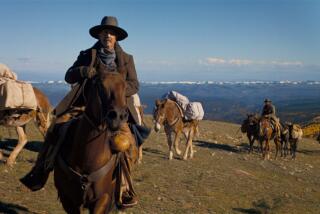Setting Times stories to music: From Cinerama to P.M. Dawn

We had a cinematic vibe to the Great Reads this week, with stories about ultra-low-budget-filmmaking and French film buffs hustling for tickets at Cannes.
For the Cannes story, I chose a soundtrack by a band that even has a movie-themed name: Cinerama (see below, filed under: category of bands you forget you like).
It got me thinking about music movies. A few weeks back, I finally got around to seeing “20 Feet from Stardom,” about the unsung (so to speak) lot of backup singers. The whole movie’s great, but it’s worth watching just for Merry Clayton’s isolated vocal track on “Gimme Shelter.” Goosebumps.
While a fun film, I wouldn’t put it at the top of my list of music movies. The top two spots, for the moment, at least, belong to these:
No. 2: “Spinal Tap.” Friends have no doubt grown tired of me talking about turning the volume up to 11 and D minor being the saddest of all keys.
No. 1: “High Fidelity.” Like many people, I was skeptical when they transplanted Nick Hornby’s story about music obsessives from London to Chicago. (I still haven’t been able to bring myself to see the American version of “Fever Pitch.”) But a great screenplay, star John Cusack – the thinking woman’s eternal sex symbol -- and a quirky soundtrack won me over. Not to mention a classic scene involving the Beta Band’s “Dry the Rain.”
Anyway, in these roundups of the week gone by, I’d like to offer the first paragraphs of each Great Read (or, as they’re known in print, Column One) -- maybe they’ll buy your eye and you can settle in for a good weekend read. And you’ll also get the songs that inspired me while editing the stories, or reading them later if my fellow editor Millie Quan ushered them through. A story soundtrack!
#
Low-budget films rely on shortcuts
In a quiet hillside home in Topanga Canyon, filmmaker Brian McGuire instructed his cast members to take their shirts off, put their sunglasses on, snort fake cocaine and “party hard.”
The 20-person cast and crew were filming a party scene for McGuire’s low-budget production in a “borrowed” home. Permission wasn’t a problem — a friend of McGuire’s who had helped decorate the house knew where the key was.
“We didn’t even think we were trespassing, really,” McGuire said of the home, which was on the market. “We figured we’d just shoot here on a weekend when we didn’t think anyone was coming.”
By the third and final day of shooting the scene for the film, a dark comedy called “Prevertere,” the party was going really well — no damage, decent footage. Then McGuire and crew had an unexpected guest.
“A Realtor showed up with a couple of clients to show the house, and we were there shooting out this crazy party scene,” McGuire said. “All of a sudden I’m hearing that cops are on their way. So we shot this whole number in 20 minutes, when it should have been in three hours … and packed up and ran out of the house.”
McGuire, 38, knows things aren’t always easy — or necessarily legal — when it comes to low-budget filmmaking, a world filled with improvisation, favors and shortcuts.
“I’ve been close to danger, but I’ve gotten out of it,” McGuire said. “If you ever do get questioned, there are tricks to avoid trouble.”
#soundtrack: “Low Budget,” by the Kinks. At the risk of sounding like a broken record (don’t you love that phrase? you can hear the skip and repeat of it), Ray Davies is a brilliant songwriter.
#
Westlake hardware store owner dispenses tools for life
The man stepped into the hardware shop looking fed up and frustrated.
He said he owned an apartment building and one of his tenants had disappeared months ago. A girl remained inside, but she refused to pay rent and wouldn’t open the door.
“Señora, please,” Juan Duarte asked the woman behind the cash register. “What can I do?”
Bertha Wooldridge made a quick phone call, then told Duarte: “Don’t worry. Everything will be OK.”
For 33 years, the owner of Westlake Plumbing and Hardware, a mom-and-pop shop just west of downtown L.A., has sold paint and toilets, power saws and duct tape — anything you need to fix your home. But pipes and screws aren’t what draw people to the store.
It’s Wooldridge.
Each day, the electronic doorbell beeps as people walk into the aroma of metal, wood and paint, looking for the shopkeeper to patch up their lives, in ways big and small.
Beep, beep: Bertha, my gas is about to be turned off. Beep, beep: Bertha, I think there’s drug dealing on my street. Beep, beep: My son has to build a volcano for school and I’m not sure how to do it. My husband’s out of work. My back hurts. I can’t make jury duty.
Wooldridge knows everyone: lawyers, pharmacists, teachers, masseuses, community organizers, city officials. Best of all, she knows police. And in a tough neighborhood like this one, she’s not afraid to call on them.
“I’m like the Yellow Pages,” Wooldridge said with a laugh on a recent day. “I always know where to send people
#soundtrack: “Fix Me Now,” by Garbage.
#
During Syrian siege, siblings honed the art of improvised survival
Sobhi Fares ducks beneath the battered arches of a once-grand Ottoman villa. His trained eyes scan for shoots of green that spring improbably from the clutter of shattered masonry, tumbled walls and jagged shards of shrapnel.
“This one, here, you can wash it and eat it raw — but it is better with a little oil,” he says, fingering a clump of basil-like leaves. “And this,” he adds, baring spiky sprigs of purple and pale green reminiscent of chicory, “this you can chop into little pieces and add some seasoning.”
Fares, 61, is a survivor of the punishing government siege here. For nearly two years, he lived without running water, electricity or shops; the prospect of death from shelling or snipers never receded. He is a man who has emerged from the rubble physically intact, though spiritually damaged. Tears come easily to his eyes.
His urban gardens amid the Armageddon of Homs’ Old City helped sustain him and his older sister, Antoinette, during the time of hunger, persistent militant bombardments and periodic raids by cornered Islamist rebels who sacked and burned abandoned homes, churches and shops.
Tales of survival are beginning to rise from Homs’ rubble in the aftermath of a deal that allowed about 2,000 remaining rebels to evacuate the Old City this month, and also opened the way for civilians to return. Longtime residents who fled have been streaming back, stunned by the scope of destruction and anguished by the damage to their homes but relieved that they are no longer shut out.
Amid the debris and chaos, a visitor occasionally catches a glimpse of a ghostly figure with hollowed-out eyes, clothing drooping from a body shrunken from insufficient calories. Such are the ones who stayed behind.
#soundtrack: “Line of Fire,” by Junip. One of those songs I can play on repeat.
#
At memory competition, the diverse contestants are unforgettable
Each morning, Brad Zupp puts on noise-canceling headphones and a pair of goggles, the lenses blacked out except for tiny peepholes that keep each eye focused downward. He sits at his desk, shuffles a deck of playing cards and gives himself 70 seconds to memorize the order.
Zupp then sets a timer and grabs another deck to see how fast he can duplicate the order of the shuffled cards.
His fastest time so far: 65 seconds.
“I don’t do anything bizarre,” said Zupp, who performs this drill at least 10 times a day.
But what’s normal to Zupp and other contestants on the Memory Championship circuit can seem bizarre to those of us who habitually forget to buy milk at the store, who zone out on names at cocktail parties and who don’t remember birthdays or anniversaries until the day has passed.
We don’t meet a man named John and see a toilet. We don’t kill time on the exercise bike memorizing every U.S. ZIP Code. We don’t carry lists of 200-digit numbers and practice memorizing them while in line at the grocery store.
Memory competitors do.
On a rainy Saturday in March, 65 of them gathered in a Manhattan office tower for the 17th USA Memory Championship, one of several such contests held each year around the world. For nearly eight tense hours, they scrambled to rearrange playing cards, match names with faces of strangers, recall random numbers, and memorize a 25-line poem and write it down word for word, with the exact punctuation and line breaks.
There were dentists, students, nurses, teachers, writers and magicians. They ranged in age from 16 to 50, and they seemed to have little in common beyond their passion for memorization and their strenuous training routines, which usually involve sitting in isolation for several hours a day practicing.
#soundtrack: “Set Adrift on Memory Bliss,” by P.M. Dawn. Even though this samples the riff from a Spandau Ballet song, I like it.
#
At Cannes Film Festival, will write a pun for tickets
There were swarms of people in tuxedos and cocktail dresses, which meant it was time for Felix Hausfater to start working it.
¿¿¿The 19-year-old medical student from Paris caught the eye of a promising lead, gestured meaningfully, then realized it was a dead end. He whirled around to a middle-age woman — no dice — then spun again and flashed a handwritten sign to a young couple, who politely shook their heads.
“It’s been three hours. But I have some tricks for the fourth hour,” he said, grinning to a reporter.
Hausfater’s goal was hardly a glamorous party invite or even a date: It was a ticket to a new movie by the Dardenne brothers, the Belgian naturalist art-house filmmakers.
Every year, thousands of movie-industry insiders, celebrities, journalists and hangers-on descend on this glitzy seaside city in southern France for the 12-day Cannes Film Festival, where amid their partying and deal-making they see movies by the world’s most acclaimed directors.
Fans wielding camera phones, meanwhile, pack the streets hoping for a glimpse of a celebrity. (Those who might be nearby when a Marion Cotillard or Ryan Gosling sighting goes down would do well to pack some earplugs.)
But that isn’t what interests people like Hausfater. He is drawn by the films themselves, obscure art-house offerings that months later might attract barely a dozen customers to the ArcLight on a Saturday afternoon.
He and other hard-core French fans use every trick they can to work the elites for a ticket — un invitation, s’il vous plait, as their signs and sweetly haunting mantras suggest — that has fallen through the cracks.
#soundtrack: “Film,” by Cinerama. You know those bands you forget you like? This is one of them.
#
If you have ideas for story soundtracks of your own, tweet the title and artist to @karihow or @LATgreatreads with the hashtag #soundtrack.
More to Read
Sign up for Essential California
The most important California stories and recommendations in your inbox every morning.
You may occasionally receive promotional content from the Los Angeles Times.










